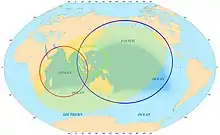Free and Open Indo–Pacific
Free and Open Indo–Pacific (FOIP) is an umbrella term that encompasses Indo–Pacific specific strategies of countries with similar interests in the region.[1] The concept has been developed through Japanese and American cooperation.[2]

Japan introduced the FOIP concept and formally put it down as a strategy in 2016. In 2019 the United States Department of State published a document formalizing its concept of a free and open Indo–Pacific.[1][3]
Origin
According to Katsuyuki Yakushiji of Toyo University, FOIP, draws from the "Arc of Freedom and Prosperity" idea which Japan advanced in 2006–07. According to the Japanese Ministry of Foreign Affairs, Prime Minister Shinzo Abe first explained Japan's commitment to the FOIP strategy in Kenya on 27 August 2016.[2][4] However even before this the concept of FOIP also falls in place with Abe's thinking of "diplomacy that takes a panoramic perspective of the world map". In 2012, Prime Minister Abe's first elucidation of FOIP went as follows:[2][5]
Peace, stability, and freedom of navigation in the Pacific Ocean are inseparable from peace, stability, and freedom of navigation in the Indian Ocean. Japan, as one of the oldest sea-faring democracies in Asia, should play a greater role—alongside Australia, India, and the US—in preserving the common good in both regions
Subsequently, in the 2017 US National Security Strategy, Asia-Pacific was exchanged with Indo-Pacific.[2]
See also
References
- Hosoya, Nicholas Szechenyi, Yuichi; Hosoya, Nicholas Szechenyi, Yuichi (10 October 2020). "Working Toward a Free and Open Indo-Pacific". Carnegie Endowment for International Peace. Archived from the original on 2020-10-29. Retrieved 2020-11-04.
- Watanabe, Tsuneo "Nabe" (30 October 2019). "Japan's Rationale for the Free and Open Indo-Pacific Strategy [1]". International Information Network Analysis | The Sasakawa Peace Foundation. Archived from the original on 2020-10-27. Retrieved 2020-11-04.
- "A Free and Open Indo-Pacific: Advancing a Shared Vision" (PDF). www.state.gov. U.S. State Department. 4 November 2019. Archived (PDF) from the original on 28 October 2020.
- "Address by Prime Minister Shinzo Abe at the Opening Session of TICAD VI". Ministry of Foreign Affairs of Japan. 27 August 2016. Archived from the original on 2020-11-07. Retrieved 2020-11-04.
- Abe, Shinzo (2012-12-27). "Asia's Democratic Security Diamond | by Shinzo Abe". Project Syndicate. Archived from the original on 2021-01-18. Retrieved 2020-11-04.
- Valencia, Mark J. (30 March 2020). "What Does a 'Free and Open Indo-Pacific' Actually Mean?". thediplomat.com. Archived from the original on 2020-11-05. Retrieved 2020-11-04.
External links
- Towards Free and Open Indo-Pacific. November 2019. The Government of Japan.